Page 87 of 404
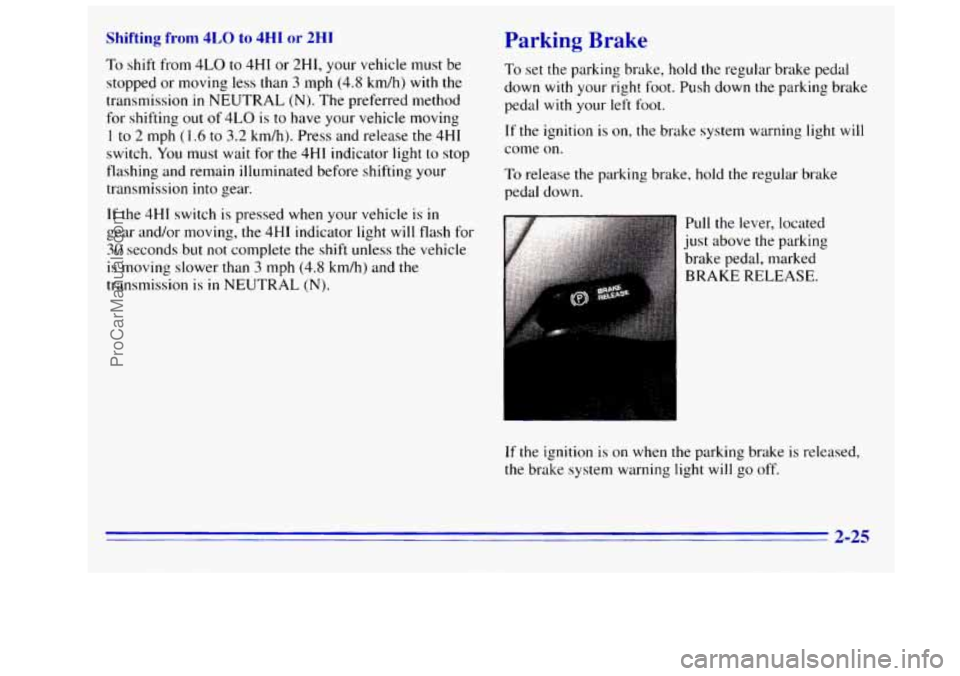
Shifting from 4LO to 4HI or 2HI
To shift from 4LO to 4HI or 2H1, your vehicle must be
stopped or moving less than
3 mph (4.8 km/h) with the
transmission in NEUTRAL (N). The preferred method
for shifting
out of 4LO is to have your vehicle moving
1 to 2 mph (1.6 to 3.2 km/h). Press and release the 4HI
switch.
You must wait for the 4HI indicator light to stop
flashing and remain illuminated before shifting your
transmission
into gear.
If the 4HI switch is pressed when your vehicle is in
gear and/or moving, the 4HI indicator light will flash for
30 seconds but not complete the shift unless the vehicle
is moving slower than
3 mph (4.8 km/h) and the
transmission is in NEUTRAL (N).
Parking Brake
To set the parking brake, hold the regular brake pedal
down
with your right foot. Push down the parking brake
pedal with your left foot.
If the ignition is on, the brake system warning light will
come
on.
To release the parking brake, hold the regular brake
pedal down.
lull the lever, located
1st above the parking
rake pedal, marked
;RAKE RELEASE.
If the ignition is on when the parking brake is released,
the brake system warning light
will go off.
2-25
ProCarManuals.com
Page 88 of 404

NOTICE:
Driving with the parking brake on can cause
your rear brakes to overheat.
You may have
to replace them, and you could also damage
other parts of your vehicle. Always check to be
sure your parking brake is fully released before
you drive.
If you are towing a trailer and are parking on any hill,
see “Towing a Trailer” in the Index. That section shows
what
to do first to keep the trailer from moving.
If you have a 3500 HD model, it is recommended that
the propshaft mounted parking brake be burnished as
part of the new vehicle break-in. The parking brake will
work best after it has been burnished following these
instructions.
Make
10 stops, using the parking brake foot pedal, from
20 mph (32 km/h) about 2 1/2 miles (4 km) apart. In
between stops, drive the vehicle at 20 mph (32 km/h).
Shifting Into PARK (P) (Automatic
Trawrission
Models Only)
It can be dangerous to get out of your vehicle if
the shift lever
is not fully in PARK (P) with the
parking brake firmly set. Your vehicle can
roll.
If you have left the engine running, the vehicle
can move suddenly. You or others could be
injured.
To be sure your vehicle won’t move,
even when you’re on fairly level ground, use
the steps that follow. If you have four-wheel
drive and your transfer case is in NEUTRAL
(N)?
your vehicle will be free to roll, even if your shift
lever
is in PARK (P). So, be sure the transfer case
is in
a drive gear -- not in NEUTRAL (N). If
you’re pulling a trailer, see “Towing a Trailer’’
in the Index.
2-26
ProCarManuals.com
Page 89 of 404
I. Hold the brake pedal down with your right foot
and set the parking brake.
2. Move the shift lever into PARK (P) position like this:
3.
0 Pull the lever toward you.
4.
5.
0 Move the lever up as fa- as it will go.
If you have four-wheel drive, be sure the transfer
case is
in a drive gear -- not in NEUTRAL (N).
Turn the ignition key to LOCK.
Remove the key and take it with you. If you can
leave your vehicle with
the ignition key in your
hand, your vehicle
is in PARK (P).
2-27
ProCarManuals.com
Page 90 of 404
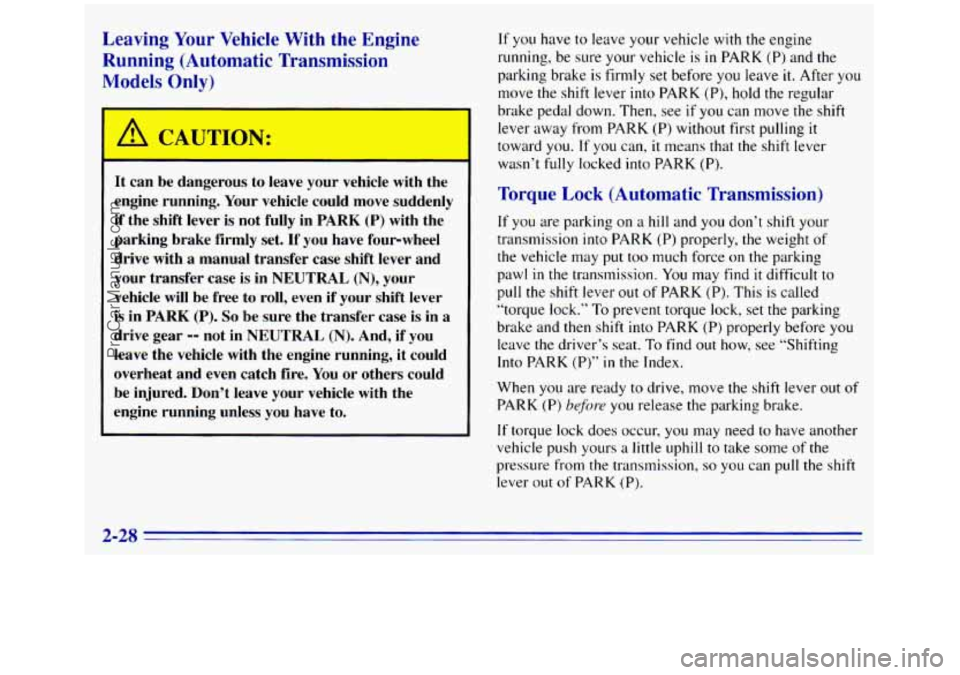
Leaving Your Vehicle With the Engine
Running (Automatic Transmission
Models Only)
I A ‘CAUTION:
It can be dangerous to leave your vehicle with the
engine running. Your vehicle could move suddenly
if the shift lever is not fully in PARK
(P) with the
parking brake firmly set.
If you have four-wheel
drive with
a manual transfer case shift lever and
your transfer case is in NEUTRAL
(N), your
vehicle will be free to roll, even if your shift lever
is in PARK (P). So be sure the transfer case is in a
drive gear
-- not in NEUTRAL (N). And, if you
leave the vehicle with the engine running, it could
overheat and even catch fire. You or others could
be injured. Don’t leave your vehicle with the
engine running unless you have to.
If you have to leave your vehicle with the engine
running, be sure your vehicle
is in PARK (P) and the
parking brake is firmly set before you leave
it. After you
move the shift lever into PARK (P), hold the regular
brake pedal down. Then, see
if you can move the shift
lever away from PARK (P) without first pulling
it
toward you. If you can, it means that the shift lever
wasn’t fully locked into PARK (P).
Torque Lock (Automatic Transmission)
If you are parking on a hill and you don’t shift your
transmission into PARK
(P) properly, the weight of
the vehicle may put too much force on the parking
pawl
in the transmission. You may find it difficult to
pull the shift lever out
of PARK (P). This is called
“torque lock.”
To prevent torque lock, set the parking
brake and then shift into PARK (P) properly before you
leave the driver’s seat.
To find out how, see “Shifting
Into PARK (P)” in the Index.
When
you are ready to drive, move the shift lever out of
PARK (P) before you release the parking brake.
If torque lock does occur, you may need to have another
vehicle push yours a little uphill to take some of the
pressure from the transmission,
so you can puIl the shift
lever out
of PARK (P).
2-28
ProCarManuals.com
Page 91 of 404
Parking Your Vehicle (Manual
Transmission Models Only)
Before you get out of your vehicle, put your manual
transmission in REVERSE (R), turn
off the engine, and
firmly apply the parking brake.
If you have four-wheel drive, be sure your transfer case
is in
a drive gear. Your vehicle could roll if it isn’t.
If you are parking
on a hill, or if you are pulling a
trailer, see “Towing a Trailer” in the Index.
Parking Over Things That Burn
f
A CAUTION:
Things that can burn could touch hot exhaust
parts under your vehicle and ignite. Don’t park
over papers, leaves, dry grass or other things that
can burn.
2-29
ProCarManuals.com
Page 93 of 404
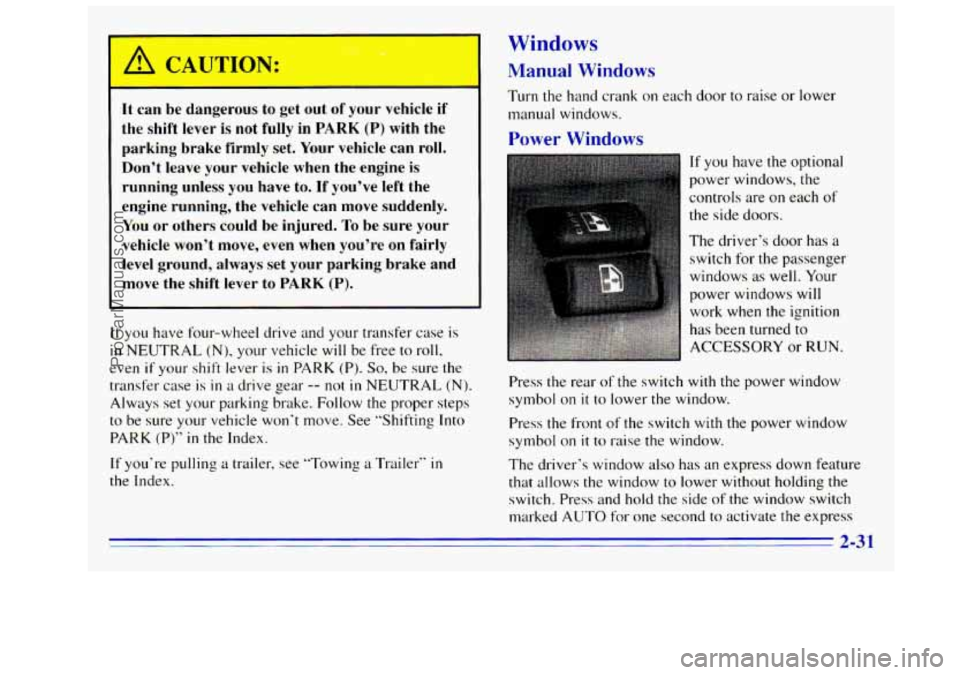
CAUTION:
.*. .
It can be dangerous to get out of your vehicle if
the shift lever is not fully in
PARK (P) with the
parking brake firmly set. Your vehicle can roll.
Don’t leave your vehicle when the engine
is
running unless you have to. If you’ve left the
engine running, the vehicle can move suddenly.
You or others could be injured.
To be sure your
vehicle won’t move, even when you’re on
fairly
level ground, always set your parking brake and
move the shift lever to PARK (P).
If you have four-wheel drive and your transfer case is
in NEUTRAL (N), your vehicle will be free to roll,
even
if your shift lever is in PARK (P). So, be sure the
transfer case is
in a drive gear -- not in NEUTRAL (N).
Always set your parking brake. Follow the proper steps
, See “Shifting Into to be sure your vehicle won’t move
PARK
(P)“ in the Index.
If you‘re pulling a trailer. see “Tow
the Index. ing
a Trailer“
in
Windows
Manual Windows
Turn the hand crank on each door to raise or lower
manual windows.
Power Windows
If you have the optional
power windows, the
controls are
on each of
the side doors.
The driver’s door has a
switch for the passenger
windows as well. Your
power windows will
work when the ignition
has been turned to
ACCESSORY or
RUN.
Press the rear of the switch with the power window
symbol on
it to lower the window.
Press the front of the switch with the power window
symbol on
it to raise the window.
The driver’s window also
has an express down feature
that allows the window to lower without holding the
switch. Press and hold the side
of the window switch
marked AUTO for one second to activate the express
2-3 1
ProCarManuals.com
Page 98 of 404
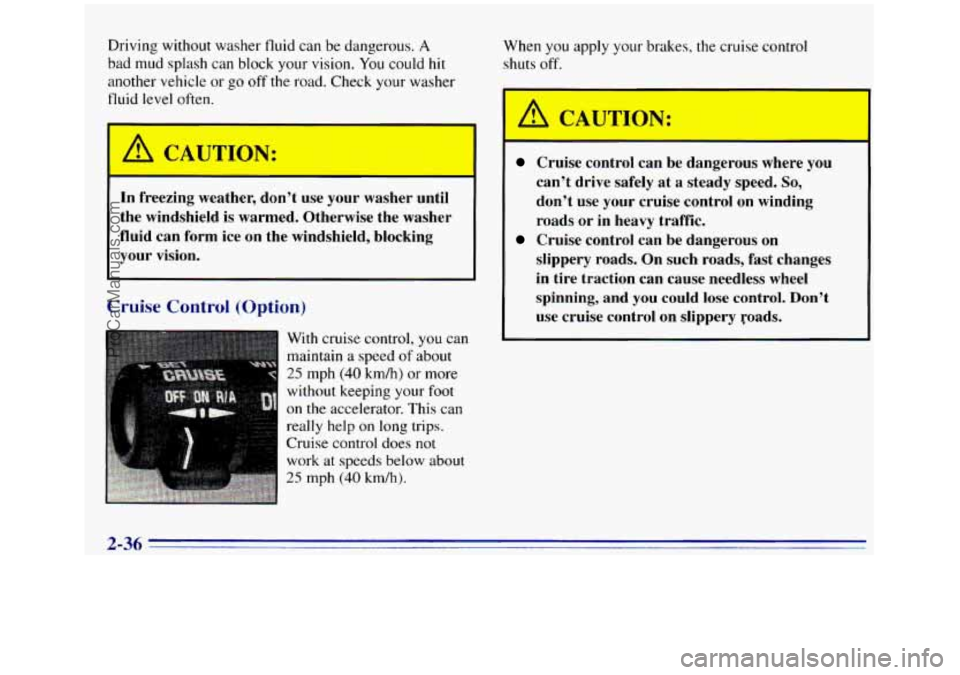
Driving without washer fluid can be dangerous. A
bad mud splash can block your vision. You could hit
another vehicle or go off the road. Check your washer
fluid
level often.
A CAUTION:
In freezing weather, don't use your washer until
the windshield is warmed. Otherwise the washer
fluid can form ice on the windshield, blocking
your vision.
Cruise Control (Option)
With cruise control, y6u Cgn
maintain a speed of about
25 mph (40 kdh) or more
without keeping your
foot
on the accelerator. This can
really help on
long trips.
Cruise control does not
work at speeds below about
25 mph (40 km/h).
When you apply your brakes, the cruise control
shuts off.
Cruise control can be dangerous where you
can't drive safely at
a steady speed. So,
don't use your cruise control on winding
roads
or in heavy traffic.
slippery roads. On such roads, fast changes
in tire traction can cause needless wheel
spinning, and you
could lose control. Don't
use cruise control on slippery yoads.
Cruise control can be dangerous on
2-36
.
ProCarManuals.com
Page 99 of 404
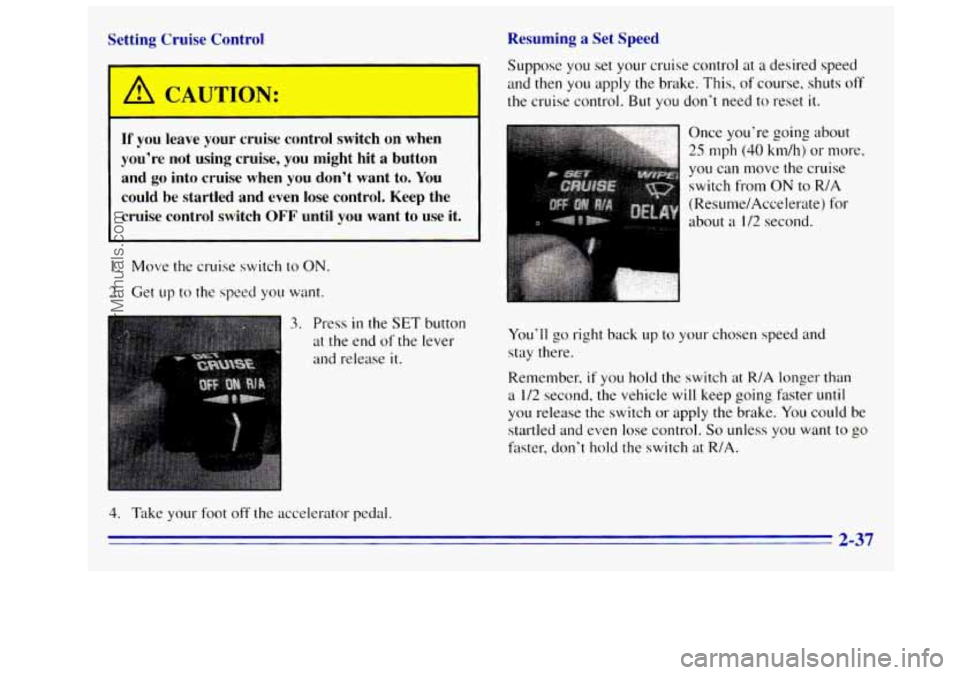
Resuming a Set Speed
Setting Cruise Control
A CAUT’3N:
If you leave your cruise control switch on when
you’re not using cruise, you might hit
a button
and
go into cruise when you don’t want to. You
could be startled and even lose control. Keep the
cruise control switch
OFF until you want to use it
1. Move the cruise switch to ON.
2. Get up to the speed you want.
3. Press in the SET button
at the end
of the lever
and release it.
4. Take your foot off the accelerator pedal Suppose
you set your cruise control
at a desired speed
and then you apply the brake. This, of course, shuts off
the cruise control. But you don’t need to reset it.
Once you’re going about
25 mph (40 kndh) or nwre,
you can move the cruise
switch from
ON to R/A
(Resull7e/Accelerate)
for
about a I /2 second.
You’ll go right back up to your chosen speed and
stay there.
Remember,
if you hold the switch at R/A longer than
a
1/2 second, the vehicle will keep going faster until
you release the switch or apply the brake. You could be
startled and e\len lose control.
So unless you want to go
faster, don’t hold the switch at R/A.
2-37
ProCarManuals.com